Tooth Cavity Symptoms: What to Know and When to Act
Tooth cavities are a common dental issue that can sneak up on you without much warning. You may brush and floss regularly, thinking everything is fine—only to feel a twinge of discomfort that makes you wonder if something’s wrong. So how do you know if you have a cavity? In this article, Surfside Smiles will walk through what a cavity feels like, how it develops, what it looks like, and when to seek treatment.
Table of Contents
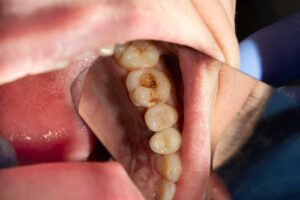
A Closer Look at Cavities
According to the Cleveland Clinic, cavities—also known as dental caries—are permanently damaged areas in the hard surface of your teeth that develop into tiny openings or holes. Left untreated, they can lead to infection, tooth loss, and more severe systemic issues.
Cavities are among the world’s most common health problems, especially in children, teenagers, and older adults. They’re primarily caused by plaque buildup, frequent snacking on sugary or acidic foods, and poor oral hygiene. The earlier a cavity is detected, the easier it is to treat without invasive procedures.
Tooth decay begins when plaque—a sticky film of bacteria—builds up on your teeth and produces acids after consuming sugar or starches. These acids attack the enamel, which can eventually lead to cavities. Over time, the plaque and acid exposure can even affect the softer root surfaces of the teeth, especially in older adults with receding gums.
As the American Dental Association (ADA) explains, tooth decay is not limited to children. Adults are also at risk due to gum recession and aging dental work. Fillings can wear out, creating crevices where bacteria thrive, leading to further decay around old dental restorations.
How Do Cavities Form?
A cavity develops when bacteria feed on sugars in your food and produce acids that wear away your enamel. The process begins with plaque, a sticky bacterial film that hardens into tartar. Tartar continues to erode the enamel, creating small holes in your teeth.
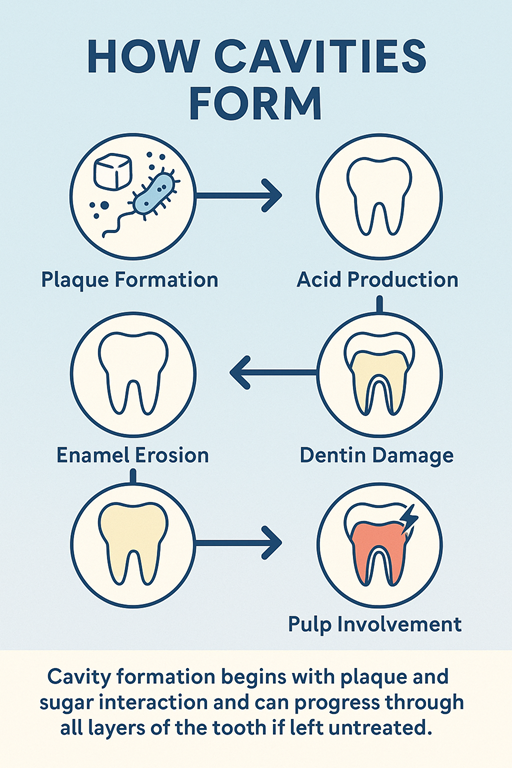
Recognizing What a Cavity Feels Like
Early Sensations of a Cavity
-
Mild Sensitivity: You might feel slight discomfort when consuming hot, cold, or sweet foods. It’s often easy to dismiss.
-
Discomfort When Biting: Biting on hard or chewy foods may feel “off,” even if it doesn’t hurt.
These subtle signs might not seem serious, but they could be early indicators of decay.
Moderate Cavity Sensations
-
Increased Sensitivity: That twinge becomes a sharper, more consistent sensation.
-
Sharp Pain: You may feel sudden, stabbing pain, often while eating or drinking.
-
Aching Tooth: A dull ache that lingers or worsens when consuming sugary or cold items.
Advanced Cavity Sensations
-
Intense, Prolonged Pain: Constant throbbing, even when not eating.
-
Tooth Sensitivity to Air: Inhaling cool air can trigger discomfort.
-
Swelling and Tenderness: Inflammation around the tooth or gums may appear.
These symptoms often mean the cavity has reached the tooth’s nerve.

How Can You Tell If You Have a Cavity?
Aside from the sensations, look for:
-
Dark Spots: Cavities often show up as brown, black, or gray spots.
-
Visible Holes: Larger cavities may appear as visible pits or holes.
-
Rough Texture: The tooth might feel uneven or rough to the tongue.
Not all cavities are visible or painful—some are only detectable during a dental exam. That’s why regular checkups are essential.
Tooth Cavity Sensations vs. Other Dental Issues
Gum Disease
Symptoms include red, swollen, or bleeding gums. This condition affects gum tissue more than the teeth.
Cracked Tooth
A cracked tooth can mimic cavity pain but often causes more intense, localized pain when biting.
When in doubt, schedule a visit. A dental exam is the only way to pinpoint the issue.
What Does a Cavity Look Like?
What Does a Decay Tooth Look Like?
It may appear as a shadow, brown stain, or visible pit on the surface.
What Does a Molar Cavity Look Like?
Decay between molars is common and often appears as dark spots between two teeth. A dental photo or x-ray usually confirms it.
Root Cavity Appearance
Root cavities typically develop near the gumline and appear as yellowish or soft areas.
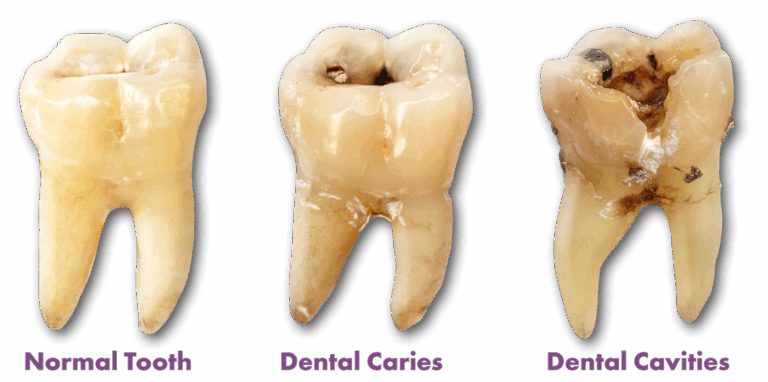
Cavity Treatment Options You Should Know
Dental Fillings
Used for minor to moderate cavities. The decayed portion is removed and filled with a composite material.
Dental Crowns
Recommended when decay is extensive. Crowns preserve the tooth’s structure and restore function.
Root Canals
Needed when the cavity reaches the pulp or nerve. The infected tissue is removed and the tooth is sealed.
Tooth Extractions
Required for severely damaged teeth. Follow-up options include bridges or dental implants.
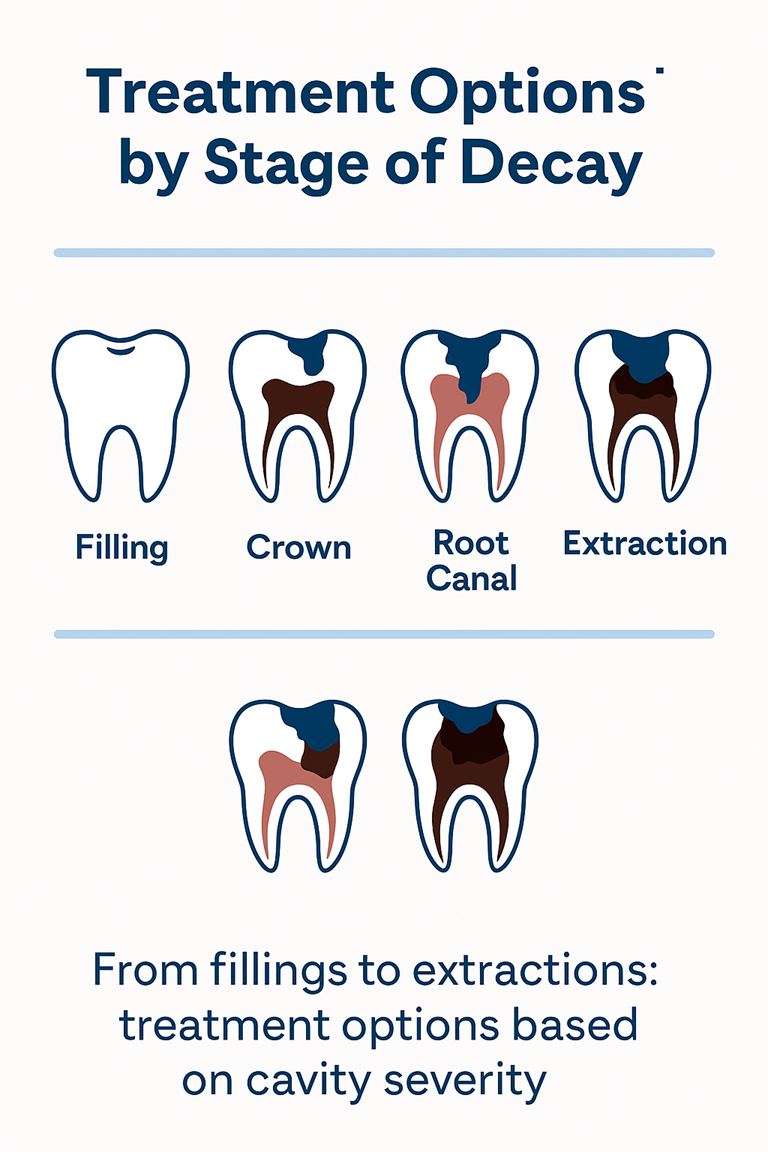
When Is a Cavity Considered an Emergency?
Call your dentist immediately if you experience:
-
Severe or persistent pain
-
Swollen gums
-
Fever
-
Pus or discharge
-
Difficulty swallowing or breathing
These signs may indicate a spreading infection or dental abscess.
Prevention and Next Steps
The Cleveland Clinic and the American Dental Association recommend a comprehensive approach to preventing tooth decay:
-
Brush twice a day with a fluoride toothpaste to strengthen enamel.
-
Floss or use an interdental cleaner daily to remove plaque between teeth.
-
Limit sugary snacks and drinks, which feed acid-producing bacteria.
-
Eat balanced, nutritious meals and drink plenty of water.
-
Consider dental sealants, especially on the chewing surfaces of molars.
-
Ask your dentist about supplemental fluoride treatments.
-
Visit your dentist regularly for professional cleanings and exams.
Preventive care is the most effective way to avoid cavities and more invasive dental treatments in the future.
The Cleveland Clinic also emphasizes that brushing twice a day with fluoride toothpaste, flossing daily, reducing sugar intake, and getting regular dental cleanings are the most effective ways to prevent cavities. They suggest asking your dentist about fluoride treatments or dental sealants, which can offer an extra layer of protection against decay—especially in kids and teens.
Does Sensitive Teeth Mean Cavity?
Tooth sensitivity isn’t always a cavity, but it can be a warning sign. If sensitivity persists, schedule an exam.
Does Tooth Sensitivity Mean Cavity or Something Else?
Sensitivity might stem from enamel erosion, gum recession, or whitening products. Still, it’s best to rule out cavities early.
Can You Feel a Cavity With Your Tongue?
Yes, many people can feel a cavity as a rough patch or small hole, especially in the molars.
Brushing and Diet Tips to Prevent Cavities
-
Brush with fluoride toothpaste twice daily
-
Floss every day
-
Limit sugary snacks and drinks
-
Stay hydrated
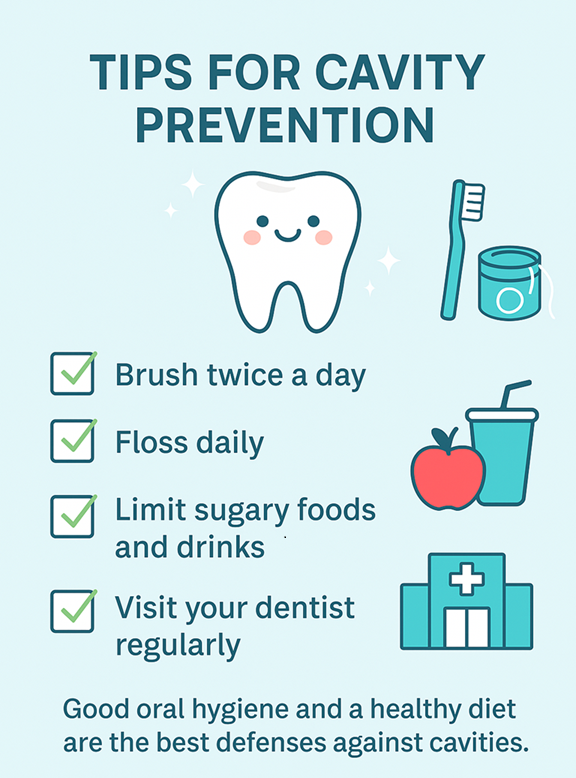
Surfside Smiles: Your Local Surfside Beach Dentist for Cavity Care
What to Expect from Your Visit
When you visit Surfside Smiles, our team will perform a thorough exam using digital imaging to detect cavities early—even before symptoms begin. We take time to explain your diagnosis and treatment options, so you feel confident and informed every step of the way.
Gentle, Modern Dentistry to Treat Cavities Early
Our approach to cavity care is focused on comfort, prevention, and preservation. Whether you need a small filling or more advanced treatment like a crown or root canal, we use minimally invasive techniques and tooth-colored materials to restore your smile naturally and effectively.
Book Your Cavity Consultation Today
Don’t let a small cavity turn into a big problem. Whether you’re experiencing sensitivity or just due for a checkup, the friendly professionals at Surfside Smiles are here to help.
Call Us: (843) 848-2483
Website: SurfsideDental.com
Address: Serving patients across Surfside Beach and surrounding areas.
Ready to schedule a checkup? Don’t wait until the pain worsens—contact Surfside Smiles today to stay ahead of cavities and keep your smile healthy.
